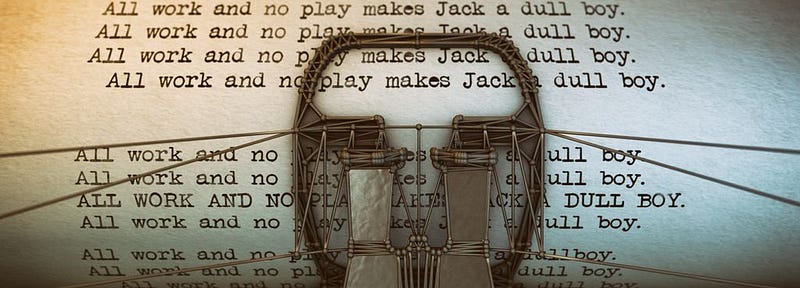
Imagine you walk into your CEO’s office and see her sitting at her desk looking out the window daydreaming. You might think, “Caught you, you were doing absolutely nothing!”, perhaps you may even feel some animosity towards her because “She gets paid the big bucks, yet here she is doing nothing!”
What if instead of slacking, she was actually leading by example? What if this approach is what we all should be doing? What if research validated this behaviour?
Psychologists have long speculated about the role of daydreaming in creativity, yet very few companies and even fewer employees would ever feel adequately psychologically safe to do so. There are many studies that validate the role of daydreaming in creativity. Cognitive scientist Roger Shepard (1978) and John Flowers and Calvin Garbin (1989) suggest that daydreaming facilitates the formation of novel associations and the recombination of mental images, which can be a source of creative ideas.
We need mental white space in order to be at our most creative.
The Curse of 100% Billable Time

In many creative agencies, advertising agencies and consultancies where revenue is dependent on billable time, there is immense pressure both explicitly and psychologically to devote all your time to billable projects. Last week’s guest on the innovation show, agency founder and creative director Justin Dauer told us that in most agencies if an employee was “caught” by a manager reading a white paper, perusing a blog or God forbid looking at some art! A question is raised about that employee. Does this person have enough work on their plate? Should we give them more work? Clocking off billable time is akin to that employee sticking their head above the parapet only to receive a volley of shots. In practice, many workers will often shield their screen or switch between browsers to avoid scrutiny based on the content of their screens or the subject of their thoughts.
This approach is counterproductive.
Everything exists in duality, yin and yang, the foreground and the background, the positive and the negative. Physiologically we are not designed to retain an “always-on” state. We need sleep to enable action, we need “rest and digest” to enable “fight or flight”. Equally, we cannot always remain in a left-brained, narrow-focused mode of thinking. We need some “off” to enable “on”.

If you perform strength training, you work your muscle, then you must then let it rest, allowing the muscle to develop before you should work it again. In a similar way, if you study intensely for a certain period of time, you must allow some time for this information to be absorbed, known as the spacing effect. With the spacing effect, we are better able to recall information and concepts if we learn them in multiple, spread-out sessions, interspersed by breaks. It may seem counterintuitive, but it works.
If your people are to stand a chance of performing to their best, then they must be allowed the mental white space to power creativity. Regular breaks are good. Chats by the water cooler are good. Daydreaming is good. On the innovation show, Justin Dauer calls this “pausing with intent”.
Whole-Brain Working

On a recent episode of the innovation show, Waqās Ahmed tells us about psychiatrist and psychologist, Iain McGilchrist. In his book ‘The Master and His Emissary, The Divided Brain and the Making of the Western World’, McGilchrist suggests that the dominant mode of thinking of certain periods in history manifest in how those societies and cultures are characterised and what they produce. The most creative and innovative periods of history such as “The Renaissance (the Rebirth)” and “The Enlightenment” were a result of the dominant mode of thinking of those periods of time. In creative periods the right-brain mode of thinking dominated, characterised by open thinking, possibility thinking and innovation. Left brain-thinking, in contrast, is linear, deductive and logical and this is the mode of thinking we are experiencing today.
There is no doubt that the business environment of today is dominated by left-brain modes of thinking. This is why organisations full of very intelligent individuals are experiencing falling profits, disruption and increasingly complete extinction. Such organisations are dominated by left-brain certainty-thinking where it is very difficult to imagine a different way for the step forward always looks like a step back.
“There is nothing in a caterpillar that tells you it’s going to be a butterfly.” — R. Buckminster Fuller
If you are dominated by a left-brain mode of thinking, you will certainly struggle to experiment with new business models, because to change business models, you must first change mental models. Herein lies the challenge.
With every duality, both modes are important. You may require the right brain mode to imagine a business, but you need your left brain mode to manage that business.
Iain McGilchrist tells us it is not true that one side does reason and the other does emotion, both reason and emotion employ both hemispheres of the brain. He says to perform most tasks we require both modes, both hemispheres working together, we require whole-brain thinking.
In the business environment, we need whole-brain thinking more than ever, the left hemisphere to focus on the present, the management of the core business and the right hemisphere to reimagine the future. Because organisations are but a mass of individuals, we all must adopt whole-brain thinking, but more importantly, the example must come from the top. A leader must be the change they want to see.
Nipping It In The Bud
To stop this current situation we must eradicate the problem, not the symptom. The problem begins at a young age when our children are pushed to “achieve” rather than just “be”. Simply Being will naturally lead them to whom they are meant to become, like all of us if we listen to our gut pheeling system.
Future guest on the innovation show Tina Payne Bryson tells us, despite parents’ best intentions, the extra classes and activities provided for children often end up being counterproductive for growing brains and minds. Kids’ packed schedules end up actually limiting real discovery, growth, purpose, happiness, and self-understanding. And the parents’ effort often backfires in completely unforeseen ways, causing kids to hate an activity they would’ve been really good at and enjoyed.
Tina tells us in her book “The Yes Brain Child”, co-authored with previous innovation show guest Daniel J. Siegel that numerous experts are decrying an epidemic of anxiety and depression among children. There is an overemphasis on achievement and extrinsic motivation. With success positioned this way, childhood can become a time of pressure and anxiety as kids work to fit into the expectations of others, rather than a time of free development and exploration as they discover and grow. Instead of loving to learn and getting the opportunity to learn as they learn best, through play and exploration, through imagination, curiosity and even boredom, many students feel oppressed and overwhelmed by their experiences with education. This rigidity thwarts real growth.
So my final summary of this Thursday Thought is to consider allowing those in your charges, your children, your students, your employees the opportunity to breathe. Breathe in creativity, inspiration and white space and breathe out imagination, creation and innovation.